Tatsuya Yokota
WEEP: A Differentiable Nonconvex Sparse Regularizer via Weakly-Convex Envelope
Jul 28, 2025Abstract:Sparse regularization is fundamental in signal processing for efficient signal recovery and feature extraction. However, it faces a fundamental dilemma: the most powerful sparsity-inducing penalties are often non-differentiable, conflicting with gradient-based optimizers that dominate the field. We introduce WEEP (Weakly-convex Envelope of Piecewise Penalty), a novel, fully differentiable sparse regularizer derived from the weakly-convex envelope framework. WEEP provides strong, unbiased sparsity while maintaining full differentiability and L-smoothness, making it natively compatible with any gradient-based optimizer. This resolves the conflict between statistical performance and computational tractability. We demonstrate superior performance compared to the L1-norm and other established non-convex sparse regularizers on challenging signal and image denoising tasks.
Very Basics of Tensors with Graphical Notations: Unfolding, Calculations, and Decompositions
Nov 25, 2024Abstract:Tensor network diagram (graphical notation) is a useful tool that graphically represents multiplications between multiple tensors using nodes and edges. Using the graphical notation, complex multiplications between tensors can be described simply and intuitively, and it also helps to understand the essence of tensor products. In fact, most of matrix/tensor products including inner product, outer product, Hadamard product, Kronecker product, and Khatri-Rao product can be written in graphical notation. These matrix/tensor operations are essential building blocks for the use of matrix/tensor decompositions in signal processing and machine learning. The purpose of this lecture note is to learn the very basics of tensors and how to represent them in mathematical symbols and graphical notation. Many papers using tensors omit these detailed definitions and explanations, which can be difficult for the reader. I hope this note will be of help to such readers.
Broadcast Product: Shape-aligned Element-wise Multiplication and Beyond
Sep 26, 2024



Abstract:We propose a new operator defined between two tensors, the broadcast product. The broadcast product calculates the Hadamard product after duplicating elements to align the shapes of the two tensors. Complex tensor operations in libraries like \texttt{numpy} can be succinctly represented as mathematical expressions using the broadcast product. Finally, we propose a novel tensor decomposition using the broadcast product, highlighting its potential applications in dimensionality reduction.
Adaptive Block Sparse Regularization under Arbitrary Linear Transform
Jan 31, 2024



Abstract:We propose a convex signal reconstruction method for block sparsity under arbitrary linear transform with unknown block structure. The proposed method is a generalization of the existing method LOP-$\ell_2$/$\ell_1$ and can reconstruct signals with block sparsity under non-invertible transforms, unlike LOP-$\ell_2$/$\ell_1$. Our work broadens the scope of block sparse regularization, enabling more versatile and powerful applications across various signal processing domains. We derive an iterative algorithm for solving proposed method and provide conditions for its convergence to the optimal solution. Numerical experiments demonstrate the effectiveness of the proposed method.
ADMM-MM Algorithm for General Tensor Decomposition
Dec 19, 2023



Abstract:In this paper, we propose a new unified optimization algorithm for general tensor decomposition which is formulated as an inverse problem for low-rank tensors in the general linear observation models. The proposed algorithm supports three basic loss functions ($\ell_2$-loss, $\ell_1$-loss and KL divergence) and various low-rank tensor decomposition models (CP, Tucker, TT, and TR decompositions). We derive the optimization algorithm based on hierarchical combination of the alternating direction method of multiplier (ADMM) and majorization-minimization (MM). We show that wide-range applications can be solved by the proposed algorithm, and can be easily extended to any established tensor decomposition models in a {plug-and-play} manner.
Soft Smoothness for Audio Inpainting Using a Latent Matrix Model in Delay-embedded Space
Mar 18, 2022
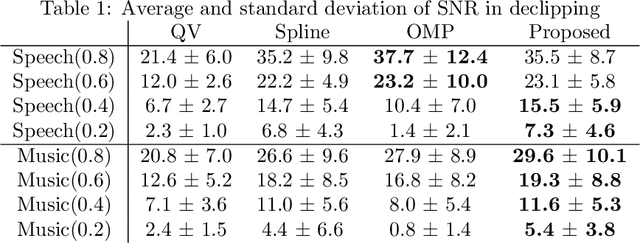


Abstract:Here, we propose a new reconstruction method of smooth time-series signals. A key concept of this study is not considering the model in signal space, but in delay-embedded space. In other words, we indirectly represent a time-series signal as an output of inverse delay-embedding of a matrix, and the matrix is constrained. Based on the model under inverse delay-embedding, we propose to constrain the matrix to be rank-1 with smooth factor vectors. The proposed model is closely related to the convolutional model, and quadratic variation (QV) regularization. Especially, the proposed method can be characterized as a generalization of QV regularization. In addition, we show that the proposed method provides the softer smoothness than QV regularization. Experiments of audio inpainting and declipping are conducted to show its advantages in comparison with several existing interpolation methods and sparse modeling.
Manifold Modeling in Quotient Space: Learning An Invariant Mapping with Decodability of Image Patches
Mar 10, 2022



Abstract:This study proposes a framework for manifold learning of image patches using the concept of equivalence classes: manifold modeling in quotient space (MMQS). In MMQS, we do not consider a set of local patches of the image as it is, but rather the set of their canonical patches obtained by introducing the concept of equivalence classes and performing manifold learning on their canonical patches. Canonical patches represent equivalence classes, and their auto-encoder constructs a manifold in the quotient space. Based on this framework, we produce a novel manifold-based image model by introducing rotation-flip-equivalence relations. In addition, we formulate an image reconstruction problem by fitting the proposed image model to a corrupted observed image and derive an algorithm to solve it. Our experiments show that the proposed image model is effective for various self-supervised image reconstruction tasks, such as image inpainting, deblurring, super-resolution, and denoising.
Block Hankel Tensor ARIMA for Multiple Short Time Series Forecasting
Feb 25, 2020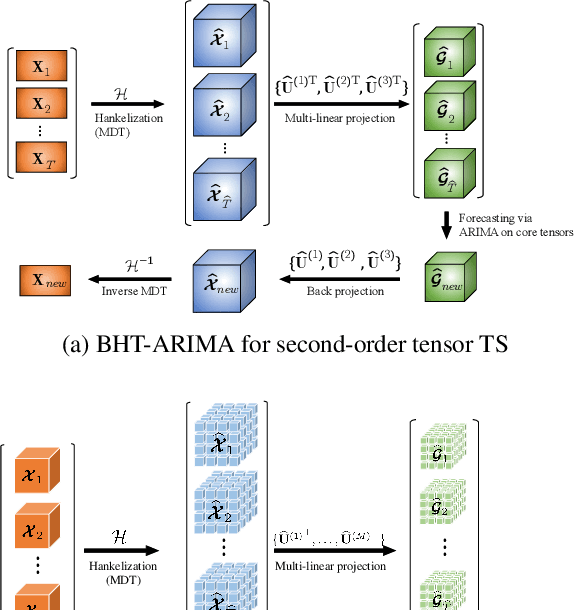
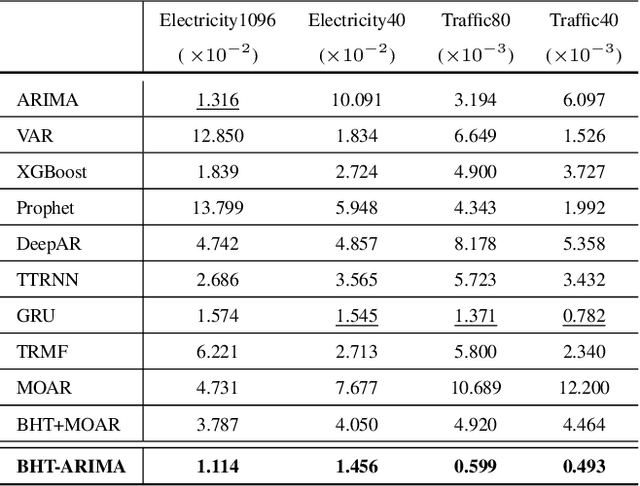
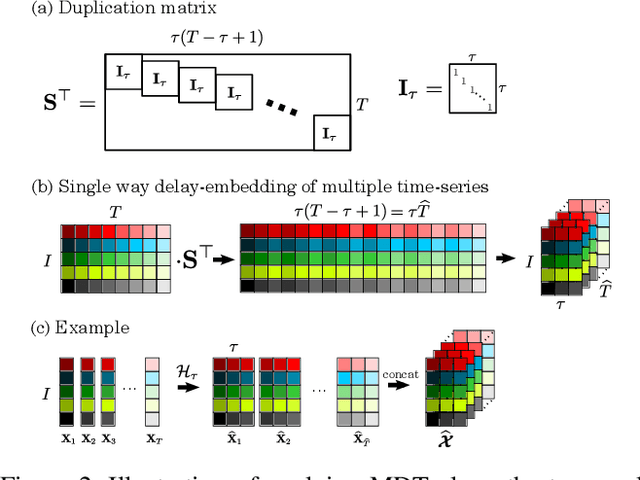
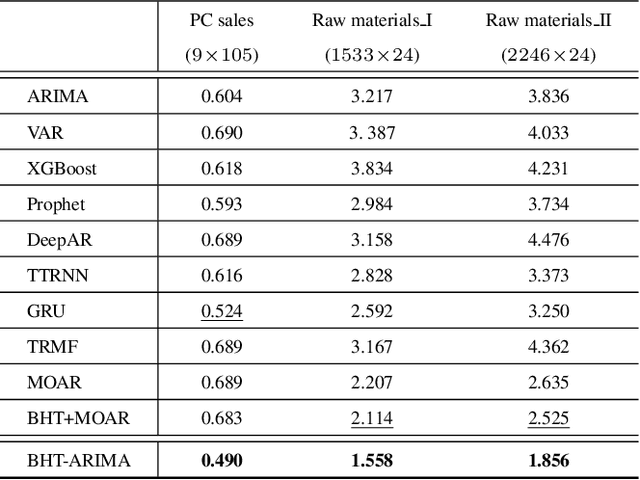
Abstract:This work proposes a novel approach for multiple time series forecasting. At first, multi-way delay embedding transform (MDT) is employed to represent time series as low-rank block Hankel tensors (BHT). Then, the higher-order tensors are projected to compressed core tensors by applying Tucker decomposition. At the same time, the generalized tensor Autoregressive Integrated Moving Average (ARIMA) is explicitly used on consecutive core tensors to predict future samples. In this manner, the proposed approach tactically incorporates the unique advantages of MDT tensorization (to exploit mutual correlations) and tensor ARIMA coupled with low-rank Tucker decomposition into a unified framework. This framework exploits the low-rank structure of block Hankel tensors in the embedded space and captures the intrinsic correlations among multiple TS, which thus can improve the forecasting results, especially for multiple short time series. Experiments conducted on three public datasets and two industrial datasets verify that the proposed BHT-ARIMA effectively improves forecasting accuracy and reduces computational cost compared with the state-of-the-art methods.
Manifold Modeling in Embedded Space: A Perspective for Interpreting "Deep Image Prior"
Aug 08, 2019



Abstract:Deep image prior (DIP), which utilizes a deep convolutional network (ConvNet) structure itself as an image prior, has attractive attentions in computer vision community. It empirically showed that the effectiveness of ConvNet structure in various image restoration applications. However, why the DIP works so well is still in black box, and why ConvNet is essential for images is not very clear. In this study, we tackle this question by considering the convolution divided into "embedding" and "transformation", and proposing a simple, but essential, modeling approach of images/tensors related with dynamical system or self-similarity. The proposed approach named as manifold modeling in embedded space (MMES) can be implemented by using a denoising-auto-encoder in combination with multiway delay-embedding transform. In spite of its simplicity, the image/tensor completion and super-resolution results of MMES were very similar even competitive with DIP in our experiments, and these results would help us for reinterpreting/characterizing the DIP from a perspective of "smooth patch-manifold prior".
Missing Slice Recovery for Tensors Using a Low-rank Model in Embedded Space
Apr 05, 2018



Abstract:Let us consider a case where all of the elements in some continuous slices are missing in tensor data. In this case, the nuclear-norm and total variation regularization methods usually fail to recover the missing elements. The key problem is capturing some delay/shift-invariant structure. In this study, we consider a low-rank model in an embedded space of a tensor. For this purpose, we extend a delay embedding for a time series to a "multi-way delay-embedding transform" for a tensor, which takes a given incomplete tensor as the input and outputs a higher-order incomplete Hankel tensor. The higher-order tensor is then recovered by Tucker-based low-rank tensor factorization. Finally, an estimated tensor can be obtained by using the inverse multi-way delay embedding transform of the recovered higher-order tensor. Our experiments showed that the proposed method successfully recovered missing slices for some color images and functional magnetic resonance images.
 Add to Chrome
Add to Chrome Add to Firefox
Add to Firefox Add to Edge
Add to Edge